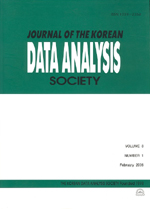항만하역 근로자의 음주동기와 음주문화 및 음주거절 자기효능감이 직무손실에 미치는 영향
The Effect of Drinking Motivation and Drinking Culture, and Drinking Refusal Self-efficacy on Work Impairment in Container Terminal Workers
- 한국자료분석학회
- Journal of The Korean Data Analysis Society (JKDAS)
- Vol.18 No.6
-
2016.123371 - 3382 (12 pages)
- 15

본 연구는 항만하역 근로자의 음주동기와 음주문화 및 음주거절 자기효능감이 직무손실에 미치는 영향을 파악하여 직무손실을 감소시킬 수 있는 대책을 마련하는데 필요한 기초자료를 제공하고자 항만하역업에 종사하는 1개 업체의 남성 근로자 213명을 대상으로 시도된 서술적 조사연구이다. 수집된 자료는 SPSS/WIN 18.0 프로그램을 이용하여 실수, 백분율, 평균, 표준편차, 평균평점, 최소값, 최대값, t-test, ANOVA를 이용하였고, 사후검정은 Scheffé test로, 변수간의 상관관계는 Pearson 상관분석을, 직무손실에 영향을 미치는 요인은 다중회귀분석을 사용하였다. 항만하역 근로자들의 음주동기가 높을수록, 음주문화의 영향이 강할수록, 그리고 음주거절 자기효능감이 낮을수록 직무손실 정도가 높은 것으로 나타났다. 직무손실에 영향을 미치는 요인은 음주동기(β=.971)와 운동(β=-.812)으로, 46.1%의 설명력을 가진 것으로 나타났다. 본 연구는 일개 지역의 항만하역 근로자를 대상으로 하였으므로 전체 항만하역 근로자에게 일반화하기에는 제한점이 있지만, 이들의 음주동기와 음주문화의 개선 및 음주거절 자기효능감 증진을 위한 중재전략 구축에 필요한 근거를 제시하였다는 점에서 의의가 있다.
The purpose of this study was to identify the factors affecting the work impairment in container terminal workers. The data were collected from March 10 to 21 in 2016. Data were collected by questionnaire from 213 container terminal workers. The instruments for this study were drinking motivation, drinking culture, drinking refusal self-efficacy and work impairment. The data were analyzed using descriptive statistics, t-test, ANOVA, Pearson’s correlation coefficients and multiple linear regression using structural questionnaire with the SPSS/WIN 18.0 program. The findings can be summarized as follows. First, the main finding here was that the degree of drinking motivation, drinking culture, work impairment was lower than and drinking refusal self-efficacy was higher. Second, the significant factors influencing work impairment were drinking motivation (β=.971), exercise regularly (β=-.812) and explained 46.1% (F=23.956, p<.005). The study reveals that it is necessary to develop a effective and practical program that decreases drinking motivation and increases regularly exercise.
1. 서론
2. 연구방법
3. 연구결과
4. 논의
5. 결론 및 제언
References
(0)
(0)